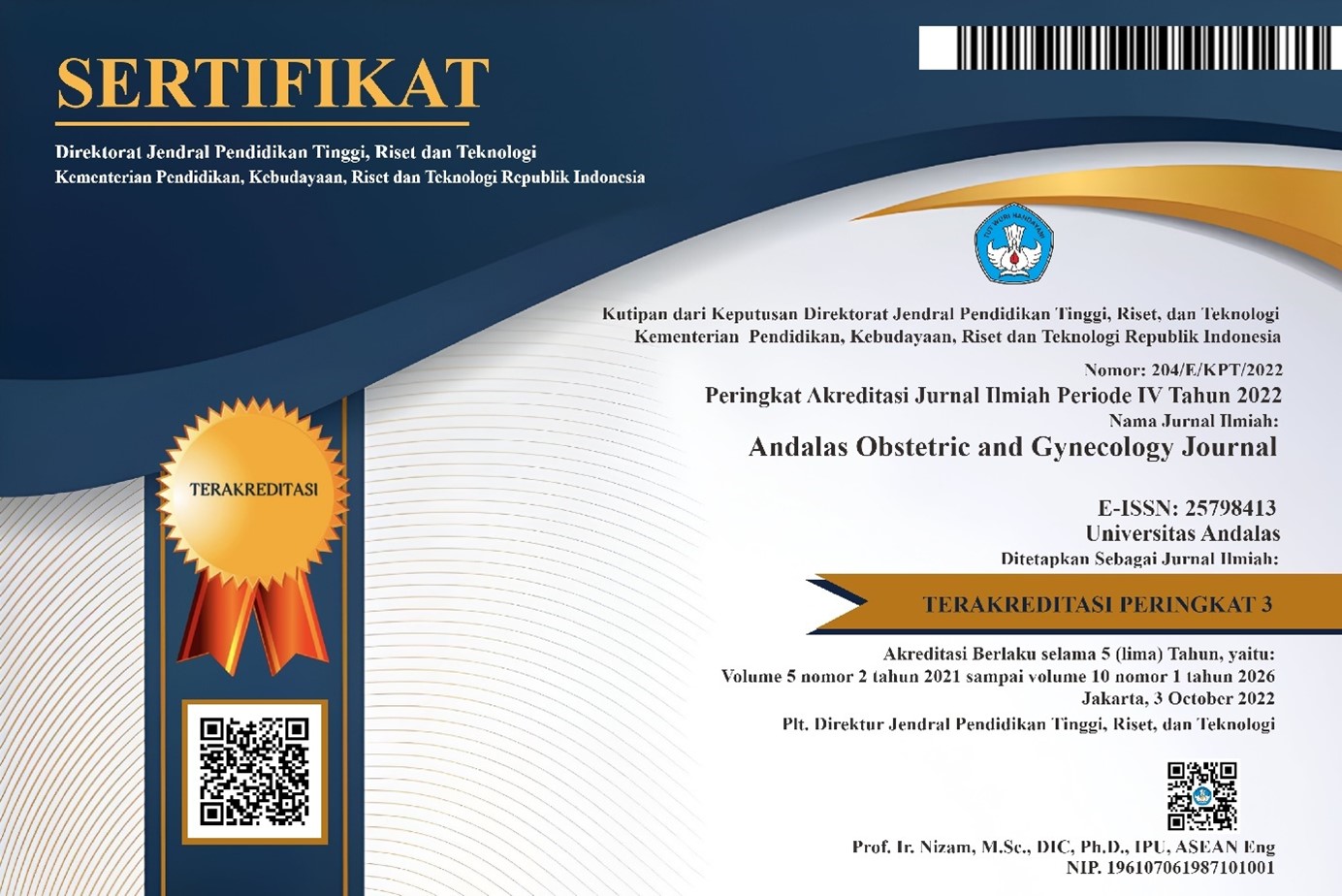Correlation between Glycated Hemoglobin Levels with Polycystic Ovary Syndrome Phenotypes and Metabolic Syndrome
DOI:
https://doi.org/10.25077/aoj.6.2.138-146.2022Keywords:
PCOS phenotype, glycated hemoglobin, metabolic syndromeAbstract
Background: Polycystic Ovary Syndrome (PCOS) is one of the endocrine disorders that causes oligo-anovulation, clinical and biochemical signs hyperandrogenism and ovarian- specific morphological signs on ultrasound examination are common in women of reproductive age. Conditions of insulin resistance and hyperandrogenism accompanied by hypertension and obesity can lead to dyslipidemia that can meet the diagnostic criteria for the metabolic syndrome. The American Diabetes Association approved the examination of glycated hemoglobin (HbA1c) levels as a routine screening for impaired glucose tolerance and hyperglycemic conditions. Examination of HbA1c levels using the method Point of Care Test. Several studies have shown a direct correlation between elevated HbA1c levels and complications of PCOS, providing evidence that HbA1c plays a potential role in PCOS. This study aims to determine the correlation between HbA1c levels with PCOS phenotype and metabolic syndrome. Methods: The study used an analytical study with a cross sectional analytic study design, the number of samples was 52 respondents. The sample was using selected consecutive sampling and then analyzed for HbA1c levels using POCT, PCOS phenotype, and metabolic syndrome for univariate and bivariate. Results: The study with 52 respondents with PCOS patients, the results showed that the number of respondents with increased HbA1c levels was 17 (32.7%) respondents, most of the respondents with phenotype A were 30 (57.7%) respondents. The number of PCOS respondents with metabolic syndrome was 21 (40.4%) respondents. The results of statistical tests showed that correlation between the PCOS phenotype and HbA1c levels. The proportion of the incidence of metabolic syndrome was higher in respondents with phenotype A than phenotypes B, C, and D. The proportion of metabolic syndrome was higher in the category of elevated HbA1c levels compared to normal HbA1c levels, based on statistical tests there was a correlation between HbA1c levels and metabolic syndrome. Conclusion: There was an increase in HbA1c levels in PCOS patients in this study, which was 32.7% and most of the respondents were with phenotype A. Less than half of the respondents had metabolic syndrome. Statistically, there is a correlation between HbA1c levels and PCOS phenotype in PCOS patients and a correlation between HbA1c levels and metabolic syndrome in PCOS patients.
Downloads
Published
Issue
Section
License
Copyright (c) 2022 Haviz Yuad, Revivo Rinda Pratama

This work is licensed under a Creative Commons Attribution 4.0 International License.
Copyright
Authors who publish with this journal agree to the following terms:
- Authors retain the copyright of published articles and grant the journal right of first publication with the work simultaneously licensed under a Creative Commons Attribution 4.0 International License that allows others to share the work with an acknowledgment of the work's authorship and initial publication in this journal.
- Authors are able to enter into separate, additional contractual arrangements for the non-exclusive distribution of the journal's published version of the work (e.g., post it to an institutional repository or publish it in a book), with an acknowledgment of its initial publication in this journal.
- Authors are permitted and encouraged to post their work online (e.g., in institutional repositories or on their website) prior to and during the submission process, as it can lead to productive exchanges, as well as earlier and greater citation of published work (See The Effect of Open Access).
License:
Andalas Obstetrics and Gynecology Journal (AOJ) is published under the terms of the Creative Commons Attribution 4.0 International License. This license permits anyone to copy and redistribute this material in any form or format, compose, modify, and make derivatives of this material for any purpose, including commercial purposes, as long as they credit the author for the original work.







